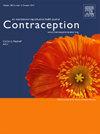多布斯诉杰克逊妇女健康组织案判决前后伊利诺伊州南部一家诊所的堕胎趋势
IF 2.8
2区 医学
Q1 OBSTETRICS & GYNECOLOGY
引用次数: 0
摘要
目标我们旨在描述多布斯诉杰克逊妇女健康组织案判决前后 12 个月内人工流产量和人工流产时妊娠持续时间的趋势。方法我们对南伊利诺伊州一家独立诊所在多布斯案前后 12 个月内进行人工流产的患者进行了回顾性队列研究。我们使用描述性统计来描述趋势,并使用独立样本 t 检验来比较多布斯案判决前后的平均妊娠时间:研究期间共发生了 12,920 例人工流产:多布斯前 4,666 例,多布斯后 8,254 例(增加了 177%)。总体而言,平均妊娠持续时间从 8.8±4.3 周增至 9.2±4.4 周(p<0.001),这可能是由于多布斯术后头三个月流产的绝对数量增加所致(n=2,990)。如果逐月比较,7 月和 8 月的平均妊娠持续时间增幅最大(多布斯前:8.8 周,多布斯后:10.2 周)。我们观察到,在多布斯手术后的 12 个月中,第二孕期流产的比例没有增加(14.3% vs 15.4%,P=0.11);但是,我们观察到,在 7 月(多布斯手术前为 12.0%,多布斯手术后为 16.6%)和 8 月(多布斯手术前为 15.0%,多布斯手术后为 19.6%),第二孕期流产的比例有所增加。虽然我们发现多布斯手术后平均妊娠时间和第二孕期的人工流产比例仅略有增加,但多布斯手术后两个月的人工流产量确实有所增加。这些变化可能反映了诊所能力的大幅提高,也可能反映了堕胎基金对保持限制性州居民堕胎机会的影响。本文章由计算机程序翻译,如有差异,请以英文原文为准。
ABORTION TRENDS AT A SINGLE CLINIC IN SOUTHERN ILLINOIS BEFORE AND AFTER THE DOBBS V. JACKSON WOMEN’S HEALTH ORGANIZATION DECISION
Objectives
We aimed to describe trends in abortion volume and gestational duration at time of abortion 12 months before and after the Dobbs v Jackson Women’s Health Organization decision.
Methods
We conducted a retrospective cohort study of people obtaining abortions at an independent clinic in Southern Illinois for 12 months pre- and post-Dobbs. We used descriptive statistics to characterize trends and compared mean gestational duration pre- and post-Dobbs using independent sample t-tests.
Results
In total, 12,920 abortions occurred in the study period: 4,666 pre-Dobbs and 8,254 post-Dobbs (177% increase). Overall, the mean gestation duration increased from 8.8±4.3 weeks to 9.2±4.4 weeks (p<0.001), likely due to the increase in the absolute number of first trimester abortions post-Dobbs (n=2,990). When compared month-by-month, the largest increases in mean gestational duration were in July and August (pre-Dobbs: 8.8 weeks, post-Dobbs: 10.2 weeks). We observed no increase in the proportion of second trimester abortions in the 12 months post-Dobbs (14.3% vs 15.4%, p=0.11); however, we observed an increase in the proportion of second trimester abortions in July (12.0% pre-Dobbs, 16.6% post-Dobbs) and August (15.0% pre-Dobbs, 19.6% post-Dobbs).
Conclusions
Post-Dobbs, we observed a nearly two-fold increase in abortion volume. While we found only a slight increase in mean gestational duration and proportion of abortions occurring in the second trimester post-Dobbs, we did see an increase in the two months after Dobbs. These changes may reflect the clinic's dramatic increase in capacity or the impact of abortion funds on maintaining abortion access for people in restrictive states.
求助全文
通过发布文献求助,成功后即可免费获取论文全文。
去求助
来源期刊

Contraception
医学-妇产科学
CiteScore
4.70
自引率
17.20%
发文量
211
审稿时长
69 days
期刊介绍:
Contraception has an open access mirror journal Contraception: X, sharing the same aims and scope, editorial team, submission system and rigorous peer review.
The journal Contraception wishes to advance reproductive health through the rapid publication of the best and most interesting new scholarship regarding contraception and related fields such as abortion. The journal welcomes manuscripts from investigators working in the laboratory, clinical and social sciences, as well as public health and health professions education.
 求助内容:
求助内容: 应助结果提醒方式:
应助结果提醒方式:


